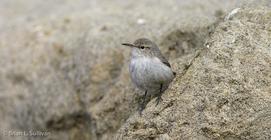ROCK WREN, LAZULI BUNTING OR-329
Hell’s Canyon, Copperfield, Oregon
May 27, 4:43 a.m.
Sunrise at 5:06 a.m.
With a fine Hell's Canyon overlook, this rock wren rocks. Hear how successive songs are never the same, though it's difficult at times to hear the pattern in his performance because he's drowned out by the lazuli bunting.
I'm going to give it a try, starting with the song at 0:27 when the bunting interferes a little less. Here's what I see in the sonagrams: A B C D B C E (0:50, obscured by bunting song) F G H I F G J G K H . . .
I've had enough! I get the picture. In 17 songs, he's delivered 11 different songs, moving through his song repertoire faster than any rock wren I've ever heard by giving only one rendition of many of his songs before moving on to another. What a range of possible expressions he has, from 1) repeating the same song back-to-back with slower singing, 2) alternating songs in A B A B A fashion, to 3) racing through his repertoire with few repetitions of the same song type.
Without the kind of regular repetition of songs (e.g., A B C A B C), it's a challenge to try to hear what a bird like this is doing. The best one can do is to listen for especially unique songs, such as song B (at 0:30, 0:42 in sequence above).
Background
Lazuli bunting, black-billed magpie, mourning dove, American Robin. And the sounds unfamiliar to me--could those chicken-like sounds be chukars, the croaking that of a great blue heron?

Photo by Brian L. Sullivan
